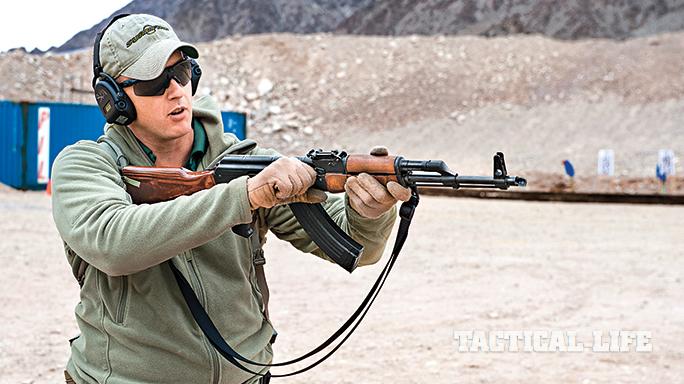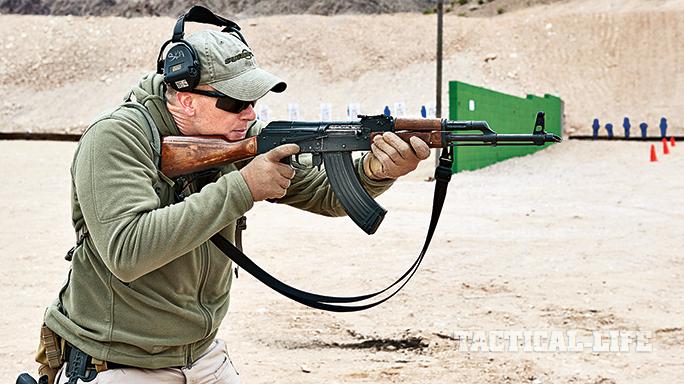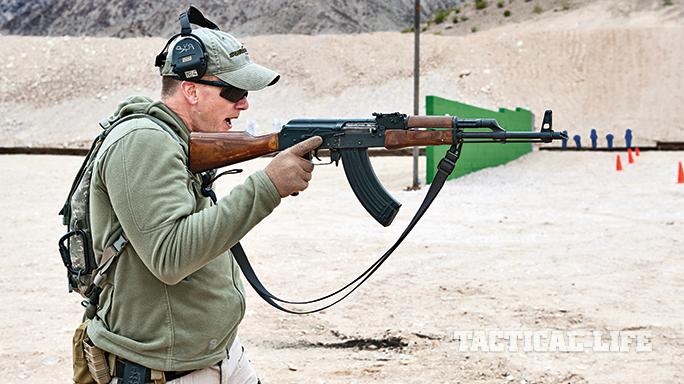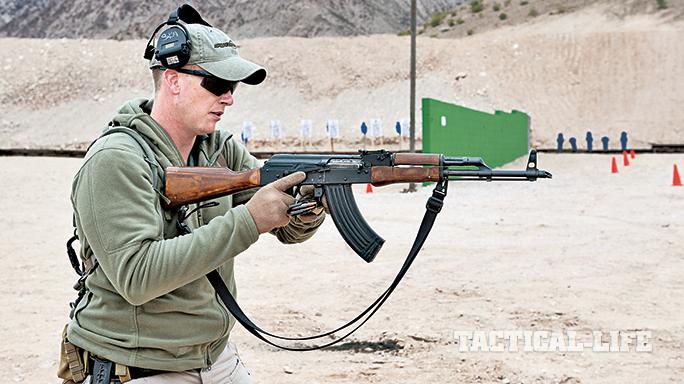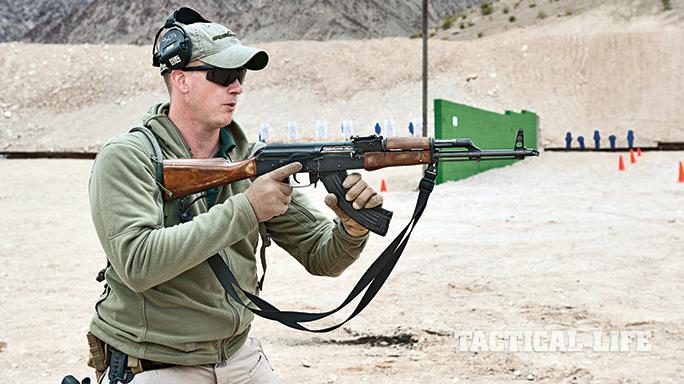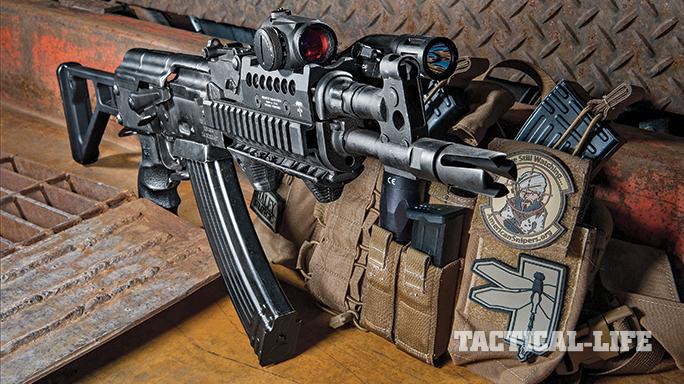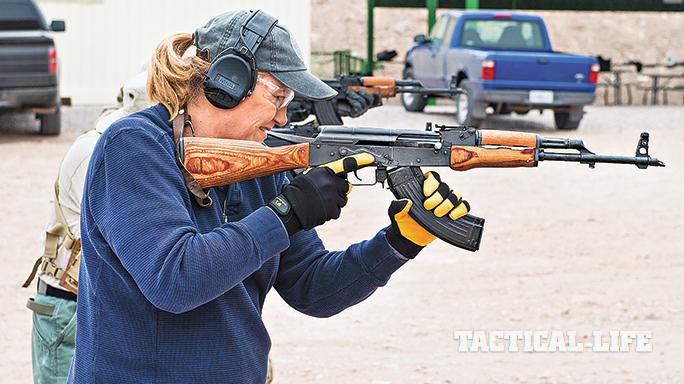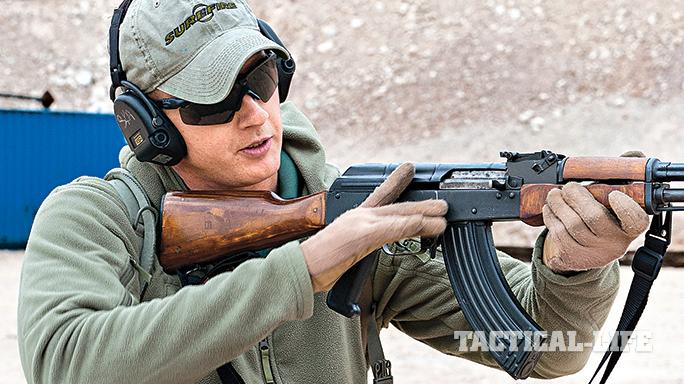The AK-47 rifle is often unfairly maligned. This is especially true with those who consider other platforms the “ultimate” in fighting rifles. The AK debate is mired in emotion, myth and misinformation. The AK has its limitations—a tack-driving target rifle it is not, nor is it a gadget collector. And while you can certainly improve the AK’s ergonomics, you should pick another rifle if you plan on hanging 10 pounds of stuff on it. AKs are simple, no-nonsense fighting tools designed to operate in any condition, and in military form they continue to be some of the most prolific combat rifles on the planet. Whether chambered in 7.62x39mm (AK-47/AKM) or 5.45x39mm (AK-74), the AK platform is dependable, sufficiently accurate and proven to be effective.
- RELATED: Birth of the AK: A History of the Avtomat Kalashnikova
- RELATED: SureFire Institute Shotgun Training | VIDEO
The majority of rifle training here in the United States is geared for the AR, the most popular platform in the country and familiar to instructors and students alike. Using an AK (especially a stock model) in these classes can be problematic, as instructors often have no clue as to how to teach it. Thus, locating classes designed around the AK can be really helpful to enthusiasts and users wanting to maximize their capabilities with the platform. Unfortunately, such classes are few and quality training is rare. Too often the courses are more about preparing for doomsday than training with your rifle. It is nice to have professional instruction taught by experienced operators, and SureFire Institute delivers exactly that with its AK-47/74 Operator class.
Tier-One Training
Advertisement — Continue Reading Below
SureFire Institute has been providing excellent firearms training in Corona, California, for years. Retired Huntington Police Officer Bill Murphy is the lead instructor and currently works part-time as a Los Angles County Sheriff’s deputy. He has been teaching officers, troops, Tier-One operators and civilians all over the world for decades. He recently had the opportunity to open a SureFire Institute facility in Nevada, bringing his expertise to a wider audience and, without the firearms restrictions in California, utilizing a much larger variety of weapons. Minutes from Las Vegas, the SureFire facility features three state-of-the-art ranges that allow for shooting out to 300 yards, plus a classroom and additional facilities. The almost unlimited space surrounding the facility offers the opportunity for significant future expansion.
Bill taught in the Middle East for years, and his SureFire Institute staff consists of retired and currently operating military trainers with extensive experience using the AK in the field. These elements keep the class focused on the basic operation of a simple AK rifle, with the primary goal of preparing troops, contractors and professionals to pick up an AK in the field and fight with it. This makes the SureFire Institute class perfect for those unfamiliar with the platform or for purists who keep their AKs unchanged. In fact, everyone but me used a school gun provided by SureFire Institute. If you are not sure about the AK, take the class. It will give you a good understanding of the platform, including its strengths and weaknesses.
AK Upgrades
Advertisement — Continue Reading Below
During the training I used two different rifles, and both were built or altered by Steve Palano of Barlow’s Custom Guns. Palano is a former Army Ranger with a no-nonsense attitude about weapons and a huge wealth of knowledge about the AK system. He has spent years fighting with, fighting against and building AK-based rifle systems. He is constantly working to make his enhancements better, always focusing on operational viability. Both rifles utilize his left-side charging handle modification, magazine funnel and extended magazine release. The AK-74 has his flat trigger modification, while the AKM uses a standard G2 double-hook trigger. None of the internals have been altered.
The AK-74 is an otherwise stock Interarms gun with a fixed Ace stock and Midwest Industries railed forend. An Insight Technologies MRDS is mounted in the top half of the forend, allowing for partial co-witnessing of the front sight. Incredibly rugged, the MRDS permits battery replacement without removing the sight, is adjustable for intensity and is easily adjustable for windage with a simple screwdriver. A Haley Strategic weapon light is mounted to an 11 o’clock rail. The entire rifle is coated in a Cerakote Desert Camo pattern from Red Creek Tactical. It not only looks nice but also works well in the field.
My AKM started as a Draco pistol with an 11-inch barrel. Blackheart International added an AR stock and licensed it as an SBR. I replaced the stock with a DPH Arms solid aluminum unit. The same Midwest Industries forend is utilized, this time with an Aimpoint Micro T-1 with a 2-MOA dot that offers truly co-witnessed iron sights. A tritium front sight and Krebs ghost-ring rear sight were added. The AKM’s coating is original, with regular touch-ups made via canned spray paint. Throughout the course I wore Haley Strategic’s new chest rig, which accommodated both AK-74 and AK-47 mags. The chest rig holds four rifle magazines plus two pistol magazines and has two other utility pouches. One large open pouch is set
up well for smoke or other devices. It can be used as a stand-alone rig or easily attached to plate carriers.
Advertisement — Continue Reading Below
Day One
The classroom portion consisted of a half-hour of setup and a safety briefing. Once the paperwork was out of the way, it was time to go hands-on. With the exception of me and one other attendee, none of the students had ever fired an AK—one female shooter had never spent any time with a rifle outside a .22 LR, making it a diverse group. Moving to the covered patio, Bill started with a detailed discussion on the rifle platform and its various components. Each rifle was broken down to its normal cleaning condition. Parts were inspected, cleaned, oiled and re-installed, highlighting the simplicity of the system. The sighting system was covered, including the zeroing procedure for the AK.
Zeroing your rifles is too often overlooked in AK classes. Unless students were expected to arrive with zeroed rifles, the zeroing process is critical. Starting at 25 yards, we set up our rifles to impact about 1.5 inches low, putting them dead on at 50 yards and within a few inches, up or down, out to 300 yards. At 50 yards our zeroes were confirmed and finally dialed in at 100 yards.
Advertisement — Continue Reading Below
My AK-74 was flawless and pretty accurate—groups at 25 and 50 yards were right at an inch or less. At 100 yards from an unsupported prone position, I was able to produce a solid group at right around 1.5 inches. With Hornady’s V-Max ammunition, this rifle tends to hold close to 1.5 MOA using the MRDS or a similar dot system.
After lunch we started in on reloading. To keep things simple, we were encouraged to use only the speedload. We covered tactical loads, but the idea was to keep the guns loaded and running for the remainder of the class. Several methods for running the bolt were covered. With a standard AK, the bolt-running method depends on the situation and your gear—know all the methods and use what works best for you. Once everyone could keep the rifles fed, it was time to work on positions. Rounds were fired on steel at 50 and 100 yards from the prone, seated, kneeling and squatting positions, and we had the means to tactically move between the positions. Everyone left the range with zeroed rifles and simple operational skills. Daytime shooting ended with full-auto AK-47 familiarization. We each ran a “one 3-round magazine, one trigger press” drill. It not only was fun, but also showed how difficult controlling a 7.62mm AK on full-auto can be.
After dinner we returned for the night shoot. We started with no light, which gave us a sense of how hard seeing those sights in the dark can be—even in failing light, they are hard to pick up, and in darkness they are all but impossible. Using my AKM at 50 yards, I could identify neither the target nor the sights (even with the Aimpoint Micro T-1). But add some light and there are no issues. With my light and using the red
dot, I was able to see and hit the target at 100 yards, and with a really powerful light you can make it out to 300 yards. The bottom line is you need
a light on your long gun.
Advertisement — Continue Reading Below
Day Two
We started the day with a brief lecture on the trajectory of the various AK rounds. The lecture was simple and straightforward, mostly providing us an idea of how things work at 200 and 300 yards. It was a good illustration of how the 50-yard zero works with a center hold, from 25 to 300 yards, for hits on target. Starting at 100 yards, the zeros were confirmed from prone, and zeroing with the Aimpoint Micro T-1 was convenient. No tools needed—just use the caps. (Just don’t lose the caps. While you can move the dials with a bullet point, the caps make doing so much easier.)
Moving to 150 yards, we fired from all of the basic positions. Prone can be difficult with the long AK magazines, but it is workable. Bill encouraged us to rest the magazine on the ground, and it worked great. I’ve done this for years and have never induced a malfunction. Moving to 200 yards, I expected the 11-inch gun to fade a bit, but not so. It nailed steel easily and gave me the chance to really dial it in. The 2-MOA dot makes longer range a bit easier—another nice feature of the T-1 sight. Hits at 200 yards from the kneeling position were regular, and from prone, easy. At 300 yards this little rifle surprised me. From prone and while using the magazine as a rest, I never missed. When I moved to kneeling, it was the same thing. So long as the rifle was steady, it smacked the steel time and time again. Even the iron-sighted rifles were getting hits. An Air Force tactical operator never missed, with his gun nailing the steel at 300 yards from every conceivable position. Was his a target rifle? Nope, but I would not want to be 300 yards from the business end of it, especially with him behind the sights!
Advertisement — Continue Reading Below
We finished out the day working on sling techniques and bringing the rifle to bear. Pretty normal stuff, but I did find the shorter barrel problematic with a couple “standard” sling techniques. Luckily, I use a sling, not a carry strap. Using my Blue Force as either a single- or two-point sling, I experienced zero issues. By attaching a couple of Magpul multi-mission clips (from Magpul’s MS3 sling), the Blue Force was really slick. Magpul’s sling is great, just too small for me. Then we trained more in full-auto fire. This time we were able to use two- and three-shot bursts. The 7.62x39mm is still a bit hard to control, but it’s certainly possible. Moving to the AK-74 in 5.45x39mm was an eye-opener. There is a reason this caliber remains the primary Russian choice: It works and it is very controllable on full-auto, accurate and fast cycling.
Real-World Ready
The class was great and a ton of fun. The ability to use school rifles and shoot fully automatic versions is a nice touch. For operators who just need familiarization or for those just interested in the platform, there is no need to buy a rifle. If you are going overseas, this course prepares you to pick up and AK and get it into the fight. Full-auto AK rifles are rare, expensive and unlawful in many areas. So being able to shoot them at the SureFire Institute course is an excellent opportunity to get a true feel for the weapon.
Advertisement — Continue Reading Below
Throughout the class there were zero malfunctions with any of the rifles. I used only about 500 rounds or so, but combine that with all the other students’ rounds and that is a ton of shooting with zero malfunctions. Using Hornady’s ammunition my rifles were as accurate as these calibers get, all from mechanically stock rifles—none of my enhancements affect operation, only how you operate them. Is the AK going to take the target competitions by storm? No. Nor is it going to convert those who are emotionally attached to their particular rifles. But the AK is a great rifle that’s been proven in every conceivable condition worldwide.
For more information, visit surefireinstitute.com or call 714-701-9918.
